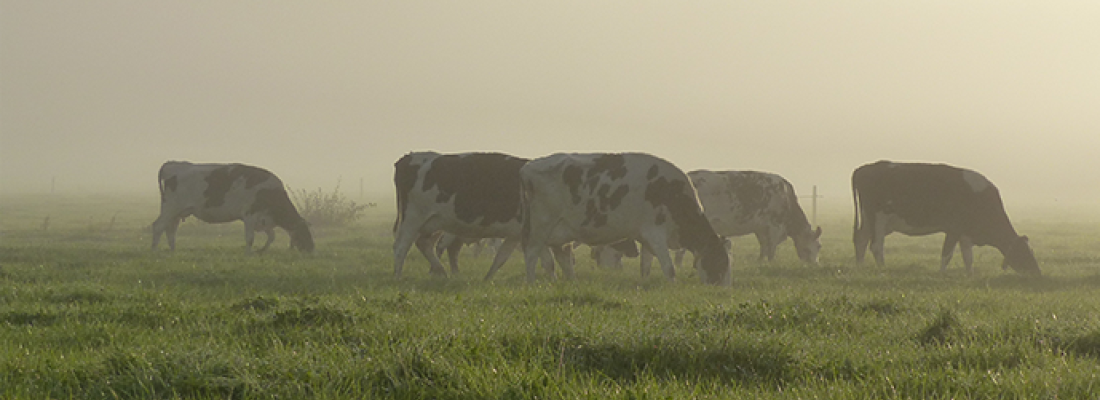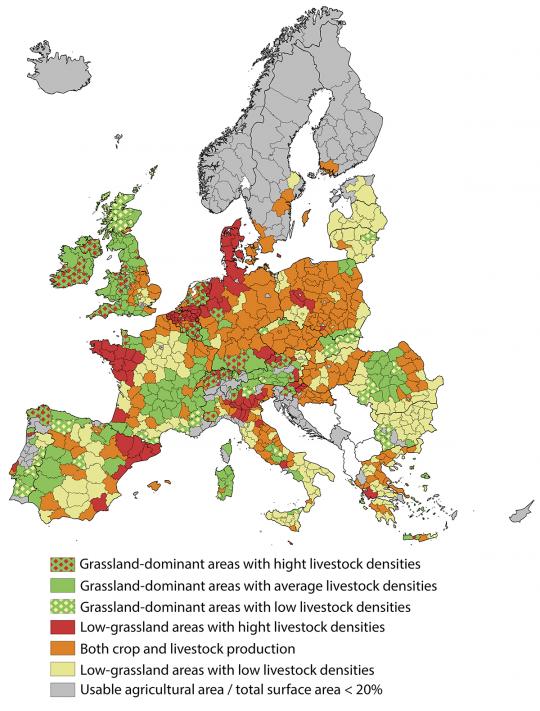Society and regional strategies Reading time 5 min
Roles, impacts and services provided by European livestock production
Published on 30 November 2016

Ten years after publication of the influential FAO report, Livestock’s long shadow1, which still provides a framework for the debate on livestock farming, what contributions can knowledge and research findings make to supplementing or confirming this global point of view? What conclusions can be drawn regarding the specific case of European livestock production?
Indeed, this industry is the subject of important societal debate and studies by scientists: the FAO report highlighted its impacts on the environment, and particularly the 18% contribution it makes to global greenhouse gas emissions (although this figure has now been revised down to 14.5%). The share of animal products in the human diet was also discussed because of the growth in global demand and competition between crops destined for human consumption and livestock feeds. Nutritional guidelines linking dietary shifts to the development of diet-related chronic diseases, and the arguments advanced by the animal rights movement, also feed concerns.
Livestock bredding is the subject of important societal debates
However, such debates are generally fragmented, and to date no study has simultaneously analysed all the dimensions affected by livestock farming. The collective scientific expert report compiled by INRA focused on exploring the corpus of recent knowledge in order to grasp this European issue in a global manner, together with its different roles, impacts, services and their interactions. The intention was to objectify the debate and avoid any heuristic or methodological bias. Thus, for example, calculating emissions of greenhouse gases per “kilo produced” versus per “hectare used” does not provide the same view and can change the relative ranking of different livestock systems, the first indicator being much more favourable towards regions with a high density of livestock production, and the second towards regions containing larger areas of grasslands.
An approach based on “service bundles”
To reflect all the effects of livestock farming, the collective scientific expert report considered simultaneously not only markets, employment and work in livestock units, the consumption of inputs, the environment and climate, but also social and cultural issues. Analysis of each of these dimensions and their components enabled an initial inventory of the situation [see insert 2]. The originality of the project was then to propose a more global analysis of the services provided, based on the “service bundle” methodology [see diagram] and on the variability of these bundles as a function of key characteristics affecting the regions concerned by livestock operations.
This approach was able to highlight antagonisms between certain services – often between the economic and environmental dimensions, for example – and emphasise the need to find trade-offs. A “service bundle” analysis could also provide foundations for scenario approaches to explore the environmental effects of reducing the consumption of animal products, associated with more extensive practices and the more efficient use of by-products for livestock feeds. While demonstrating the value of such a reduction, this study showed that even the complete elimination of livestock farming would not be able to achieve the highest levels of environmental services. Without livestock, grasslands (which play a crucial role in biodiversity and soil carbon sequestration) would tend to disappear, thus underlining the existence of an optimum that includes a share of animal products in the human diet.
Different levers in different regions

This approach was applied to a regional typology based on three main types of region [see map] and generated different action levers in each case. In regions with a high animal densities and minimal permanent grassland, accounting for a third of the European livestock herd and mainly found in Denmark, the Netherlands, Northern Germany and Western France, the management of pollution induced by the high concentration of animals, and limitations on inputs, are central to local decision-making.
These systems, which are principally devoted to supplying products of standardised quality at optimised costs, are highly sensitive to the economic climate, over which they have no influence. Action levers for poultry and pig farmers can be found in improvements to feed efficiency, the reorganisation of housing, the level of exploitation of animals, the health quality of herds and the processing of waste. For ruminants, the principal lever is to increase the use of grazing whenever possible, in order to optimise the biological roles of grasslands.
In grassland regions, ruminant units in the majority are generally associated with products that benefit from quality labels, with reduced pollution and an absence of competition with crops for human use in terms of land use. Grassland productivity determines both levels of production and product differentiation strategies. It is necessary to find a trade-off between preserving good environmental performance and penalising production potential by acting on the management of grasslands and the organisation of landscapes and sectors in order to add value to products, and by working in concert with sectoral and regional governance bodies.
Levers are organised around the maintenance of livestock activities
In regions with both crop and livestock production, which display marked differences in their dynamics, action levers focus on combining the benefits of this association. Because of strong competition in these regions between livestock farming and crop development, levers are organised around the maintenance of livestock activities through the diversification of rotations, developing the feed autonomy of livestock units, or the introduction of ruminants or poultry into orchards, vineyards or paddy fields, etc.
At this stage of the analysis, the expert report has highlighted a range of research needs: to refine the added values identified for the different services so as to better integrate all the services rendered in the bundle-based analysis. It is then necessary to ensure that these service bundles will be better understood and exploited by the political decision-makers and stakeholders concerned. Finally, there is a need to refine analysis of the effects of reducing the consumption of animal products. This latter point requires the improved integration of dietary behaviours, product quality, nutrition, health impacts and the functioning of different sectors.
1 Livestock’s long shadow – L’ombre portée de l’élevage, FAO – Food and Agriculture Organisation of the United Nations, published in 2006.
Key figuresEuropean livestock production The collective scientific expert report considered simultaneously: markets, employment and work in livestock units, the consumption of inputs, the environment and climate, and social and cultural issues, etc. An initial analysis of each dimension produced an inventory that covered the elements listed below. A more complete and refined table is available in the synthesis, and a detailed, point-by-point analysis is included in the report.
|
Managed by INRA, this expert report mobilised 27 experts drawn from INRA, other research institutions in France and other countries, advanced agricultural schools and universities. The corpus studied by these experts contained some 2500 bibliographical references.
